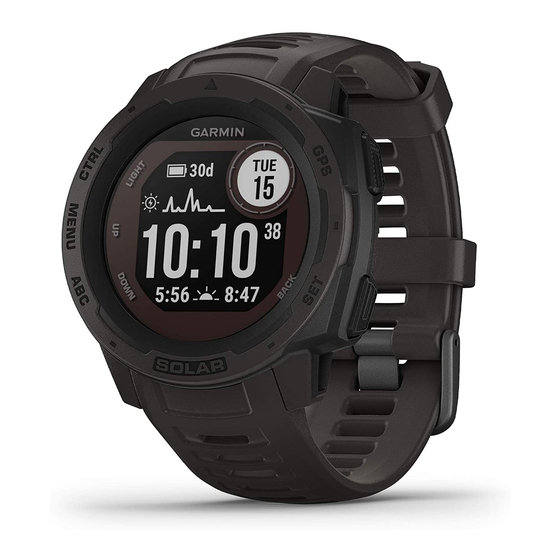Garmin INSTINCT SOLAR 소유자 매뉴얼 - 페이지 10
{카테고리_이름} Garmin INSTINCT SOLAR에 대한 소유자 매뉴얼을 온라인으로 검색하거나 PDF를 다운로드하세요. Garmin INSTINCT SOLAR 38 페이지.
Garmin INSTINCT SOLAR에 대해서도 마찬가지입니다: 빠른 시작 매뉴얼 (12 페이지)

Jump Types
The jumpmaster feature allows you to set the jump type to one
of three types: HAHO, HALO, or Static. The jump type selected
determines what additional setup information is required. For all
jump types, drop altitudes and opening altitudes are measured
in feet above ground level (AGL).
HAHO: High Altitude High Opening. The jumpmaster jumps from
a very high altitude and opens the parachute at a high
altitude. You must set a DIP and a drop altitude of at least
1,000 feet. The drop altitude is assumed to be the same as
the opening altitude. Common values for a drop altitude
range from 12,000 to 24,000 feet AGL.
HALO: High Altitude Low Opening. The jumpmaster jumps from
a very high altitude and opens the parachute at a low altitude.
The required information is the same as the HAHO jump
type, plus an opening altitude. The opening altitude must not
be greater than the drop altitude. Common values for an
opening altitude range from 2,000 to 6,000 feet AGL.
Static: The wind speed and direction are assumed to be
constant for the duration of the jump. The drop altitude must
be at least 1,000 feet.
Entering Jump Information
1
Press GPS.
2
Select Jumpmaster.
3
Select a jump type
(Jump Types, page
4
Complete one or more actions to enter your jump information:
• Select DIP to set a waypoint for the desired landing
location.
• Select Drop Alt to set the drop altitude AGL (in feet) when
the jumpmaster exits the aircraft.
• Select Open Alt to set the open altitude AGL (in feet)
when the jumpmaster opens the parachute.
• Select Forward Throw to set the horizontal distance
traveled (in meters) due to aircraft speed.
• Select Crs. to HARP to set the direction traveled (in
degrees) due to aircraft speed.
• Select Wind to set the wind speed (in knots) and direction
(in degrees).
• Select Constant to fine-tune some information for the
planned jump. Depending on the jump type, you can
select Percent Max., Safety Factor, K-Open, K-Freefall,
or K-Static and enter additional information
Settings, page
6).
• Select Auto to DIP to enable navigation to the DIP
automatically after you jump.
• Select Go To HARP to start navigation to the HARP.
Entering Wind Information for HAHO and
HALO Jumps
1
Press GPS.
2
Select Jumpmaster.
3
Select a jump type
(Jump Types, page
4
Select Wind > Add.
5
Select an altitude.
6
Enter a wind speed in knots and select Done.
7
Enter a wind direction in degrees and select Done.
The wind value is added to the list. Only wind values included
in the list are used in calculations.
8
Repeat steps 5–7 for each available altitude.
Resetting Wind Information
1
Press GPS.
2
Select Jumpmaster.
6
3
4
All wind values are removed from the list.
Entering Wind Information for a Static Jump
1
2
3
4
Constant Settings
Select Jumpmaster, select a jump type, and select Constant.
Percent Max.: Sets the jump range for all jump types. A setting
Safety Factor: Sets the margin of error for a jump (HAHO only).
K-Freefall: Sets the wind drag value for a parachute during
6).
K-Open: Sets the wind drag value for an open parachute, based
K-Static: Sets the wind drag value for a parachute during a
Setting Up Your User Profile
You can update your gender, birth year, height, weight, and
heart rate zone settings. The device uses this information to
calculate accurate training data.
1
2
(Constant
3
Fitness Goals
Knowing your heart rate zones can help you measure and
improve your fitness by understanding and applying these
principles.
• Your heart rate is a good measure of exercise intensity.
• Training in certain heart rate zones can help you improve
If you know your maximum heart rate, you can use the table
(Heart Rate Zone Calculations, page
6).
heart rate zone for your fitness objectives.
If you do not know your maximum heart rate, use one of the
calculators available on the Internet. Some gyms and health
centers can provide a test that measures maximum heart rate.
The default maximum heart rate is 220 minus your age.
About Heart Rate Zones
Many athletes use heart rate zones to measure and increase
their cardiovascular strength and improve their level of fitness. A
heart rate zone is a set range of heartbeats per minute. The five
commonly accepted heart rate zones are numbered from 1 to 5
according to increasing intensity. Generally, heart rate zones are
calculated based on percentages of your maximum heart rate.
Select HAHO or HALO.
Select Wind > Reset.
Press GPS.
Select Jumpmaster > Static > Wind.
Enter a wind speed in knots and select Done.
Enter a wind direction in degrees and select Done.
less than 100% decreases the drift distance to the DIP, and a
setting greater than 100% increases the drift distance. More
experienced jumpmasters may want to use smaller numbers,
and less experienced skydivers may want to use larger
numbers.
Safety factors are usually integer values of two or greater,
and are determined by the jumpmaster based on
specifications for the jump.
freefall, based on the parachute canopy rating (HALO only).
Each parachute should be labeled with a K value.
on the parachute canopy rating (HAHO and HALO). Each
parachute should be labeled with a K value.
static jump, based on the parachute canopy rating (Static
only). Each parachute should be labeled with a K value.
Training
From the watch face, hold UP.
Select Settings > User Profile.
Select an option.
cardiovascular capacity and strength.
7) to determine the best
Training
